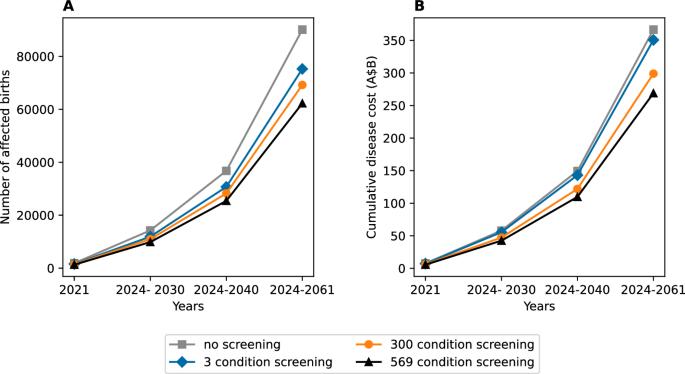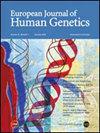澳大利亚基于人群的扩大生殖载体遗传病筛查的成本效益:微观模拟分析。
IF 4.6
2区 生物学
Q2 BIOCHEMISTRY & MOLECULAR BIOLOGY
引用次数: 0
摘要
以2021年澳大利亚人口普查为基础人口,开发了一个微观模拟模型,从卫生服务和社会角度评估基于人口的扩大生殖载体筛查(RCS)对569种隐性疾病的成本效益。该模型模拟了扩大RCS的影响,包括对有风险夫妇的下游干预对成本和结果的影响。比较对象为:(1)无人群筛查;(2)囊性纤维化、脊髓性肌萎缩和脆性X综合征的有限筛查;(3)300个条件的筛查小组。预计到2061年,扩大RCS可避免受影响的分娩和保健服务费用。从卫生服务和社会的角度来看,我们的模型预测,与模型中的其他筛查策略相比,扩大RCS可以节省成本(即,更高的质量调整生命年和更低的成本)。单个队列中避免受影响分娩的数量将从有限筛查的84例[95%置信区间(CI) 60-116]增加到扩大RCS的2067例(95%CI 1808-2376)。与300条件筛选面板相比,扩展RCS节省了成本。间接成本约占隐性疾病相关总成本的三分之一。我们的模型预测,到2061年,与目前有限的3种基因筛查相关的直接治疗成本将以每年20%的速度增长,达到734亿澳元。我们的研究结果有助于了解遗传疾病的成本负担和扩大RCS的经济效益,从而更好地为资源分配决策提供信息。本文章由计算机程序翻译,如有差异,请以英文原文为准。

Cost-effectiveness of population-based expanded reproductive carrier screening for genetic diseases in Australia: a microsimulation analysis
Using the Australian Census survey 2021 as base population, a microsimulation model, PreconMOD was developed to evaluate the cost-effectiveness of population-based expanded reproductive carrier screening (RCS) for 569 recessive conditions from the health service and societal perspectives. The model simulated the effect of expanded RCS including the downstream interventions for at-risk couples on cost and outcomes. The comparators were (i) no population screening (ii) limited screening for cystic fibrosis, spinal muscular atrophy, and fragile X syndrome and (iii) a 300 conditions screening panel. Averted affected births and health service cost with expanded RCS were projected to year 2061. At a 50% uptake, our model predicts that expanded RCS is cost saving (i.e., higher quality-adjusted life-years and lower costs) compared with other screening strategies in the model from the health service and societal perspectives. The number of affected births averted in a single cohort would increase from 84 [95% confidence interval (CI) 60–116] with limited screening to 2067 (95%CI 1808–2376) with expanded RCS. Expanded RCS was cost-saving compared to the 300-conditions screening panel. Indirect cost accounted for about one-third of the total costs associated with recessive disorders. Our model predicts that the direct treatment cost associated with current limited 3 genes screening would increase by 20% each year to A$73.4 billion to the health system by 2061. Our findings contribute insights on the cost burden of genetic diseases and the economic benefits of expanded RCS to better informed resource allocation decisions.
求助全文
通过发布文献求助,成功后即可免费获取论文全文。
去求助
来源期刊

European Journal of Human Genetics
生物-生化与分子生物学
CiteScore
9.90
自引率
5.80%
发文量
216
审稿时长
2 months
期刊介绍:
The European Journal of Human Genetics is the official journal of the European Society of Human Genetics, publishing high-quality, original research papers, short reports and reviews in the rapidly expanding field of human genetics and genomics. It covers molecular, clinical and cytogenetics, interfacing between advanced biomedical research and the clinician, and bridging the great diversity of facilities, resources and viewpoints in the genetics community.
Key areas include:
-Monogenic and multifactorial disorders
-Development and malformation
-Hereditary cancer
-Medical Genomics
-Gene mapping and functional studies
-Genotype-phenotype correlations
-Genetic variation and genome diversity
-Statistical and computational genetics
-Bioinformatics
-Advances in diagnostics
-Therapy and prevention
-Animal models
-Genetic services
-Community genetics
 求助内容:
求助内容: 应助结果提醒方式:
应助结果提醒方式:


